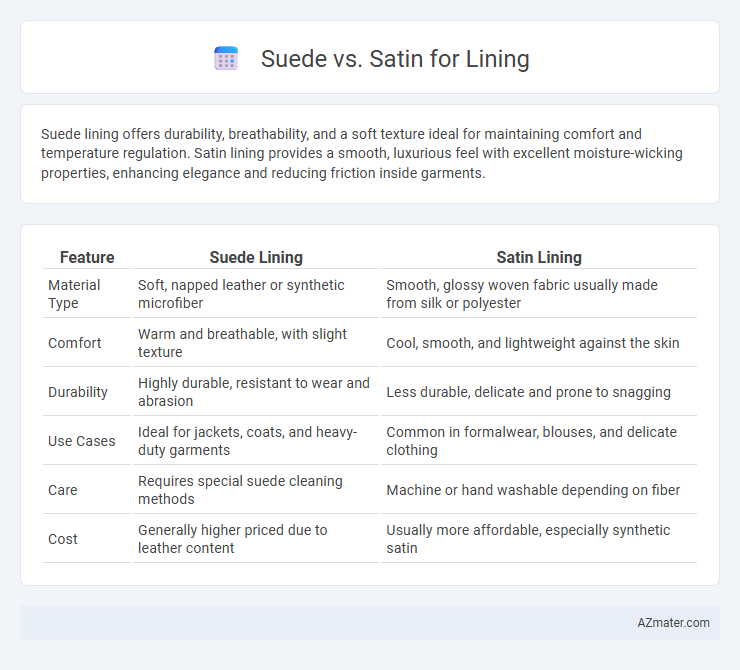Suede lining offers durability, breathability, and a soft texture ideal for maintaining comfort and temperature regulation. Satin lining provides a smooth, luxurious feel with excellent moisture-wicking properties, enhancing elegance and reducing friction inside garments.
Table of Comparison
| Feature | Suede Lining | Satin Lining |
|---|---|---|
| Material Type | Soft, napped leather or synthetic microfiber | Smooth, glossy woven fabric usually made from silk or polyester |
| Comfort | Warm and breathable, with slight texture | Cool, smooth, and lightweight against the skin |
| Durability | Highly durable, resistant to wear and abrasion | Less durable, delicate and prone to snagging |
| Use Cases | Ideal for jackets, coats, and heavy-duty garments | Common in formalwear, blouses, and delicate clothing |
| Care | Requires special suede cleaning methods | Machine or hand washable depending on fiber |
| Cost | Generally higher priced due to leather content | Usually more affordable, especially synthetic satin |
Introduction to Suede and Satin Linings
Suede lining offers a soft, textured finish made from the underside of animal hide, providing durability and a luxurious feel often used in high-end garments and accessories. Satin lining, characterized by its smooth, glossy surface woven from silk or synthetic fibers, enhances comfort and elegance by allowing garments to glide effortlessly over skin or other fabrics. Choosing between suede and satin linings depends on the desired combination of tactile experience, breathability, and aesthetic appeal in clothing or upholstery projects.
Material Overview: What is Suede?
Suede is a type of leather with a napped finish, created by sanding the inner surface of animal hides, typically from lamb, goat, or calf. It is prized for its soft texture, pliability, and matte appearance, making it a popular choice for luxurious linings in garments and accessories. Unlike satin, suede offers a warm, breathable feel with a natural grip, ideal for both comfort and durability in lining applications.
Material Overview: What is Satin?
Satin is a smooth, glossy fabric characterized by its unique weave that produces a lustrous surface and a matte back, commonly made from silk, polyester, or nylon fibers. It excels in providing a luxurious feel and elegant appearance, often used for garment linings due to its lightweight and breathable properties. Unlike suede, which is thicker and textured, satin offers a sleek, slippery finish that enhances comfort and ease of movement inside apparel.
Comfort and Texture Comparison
Suede lining offers a soft, matte texture that provides a plush, breathable feel, making it ideal for comfort in cooler climates. Satin lining features a smooth, glossy surface that reduces friction and enhances ease of movement, contributing to a luxurious sensation against the skin. While suede excels in warmth and grip, satin is preferred for its sleekness and moisture-wicking properties.
Durability and Longevity
Suede lining offers superior durability due to its dense fiber structure, making it resistant to wear and tear in high-friction areas. Satin lining, while smooth and luxurious, tends to have lower longevity as its delicate fibers can easily snag and wear thin over time. Choosing suede for lining ensures a longer-lasting interior that maintains its integrity under frequent use.
Breathability and Moisture Management
Suede lining offers moderate breathability but tends to trap moisture due to its dense texture, which can reduce overall comfort in humid conditions. Satin lining excels in moisture management by allowing better airflow and facilitating quicker evaporation of sweat, keeping the wearer cooler and drier. Choosing satin over suede for lining significantly enhances breathability and moisture control, making it ideal for warmer climates and active use.
Aesthetic Appeal and Style Options
Suede lining offers a luxurious matte finish with a soft texture that enhances the aesthetic appeal of high-end garments, providing a rich, sophisticated look ideal for premium fashion pieces. Satin lining, characterized by its smooth, glossy surface, reflects light to create a sleek, elegant effect, making it a popular choice for formalwear and delicate fabrics. Style options with suede tend to emphasize warmth and opulence, while satin provides versatility in color and sheen, catering to both classic and contemporary design preferences.
Maintenance and Cleaning Tips
Suede linings require delicate care, using a soft brush to remove dust and spot cleaning with a suede cleaner to maintain texture and prevent staining. Satin linings benefit from gentle hand washing or dry cleaning to preserve their smooth, glossy finish and prevent fabric damage. Both materials should avoid exposure to excessive moisture and direct heat to extend the lifespan of the lining.
Cost and Accessibility
Satin is generally more cost-effective and widely accessible for lining due to its smooth texture, affordability, and availability in various weight options. Suede linings, while luxurious and durable, tend to be significantly more expensive and less commonly found, often limited to high-end or specialty retailers. Choosing satin ensures budget-friendly and versatile lining options suitable for mass production or DIY projects without compromising style.
Suitability for Different Garments or Products
Suede lining offers a soft, textured feel ideal for luxury outerwear, jackets, and winter coats due to its warmth and durability. Satin lining, with its smooth, glossy surface, is preferable for formalwear, evening gowns, and lighter garments, providing comfort and ease of movement. Choosing between suede and satin depends on the desired garment function, climate, and aesthetic appeal, with suede excelling in insulation and satin in elegance.

Infographic: Suede vs Satin for Lining
 azmater.com
azmater.com